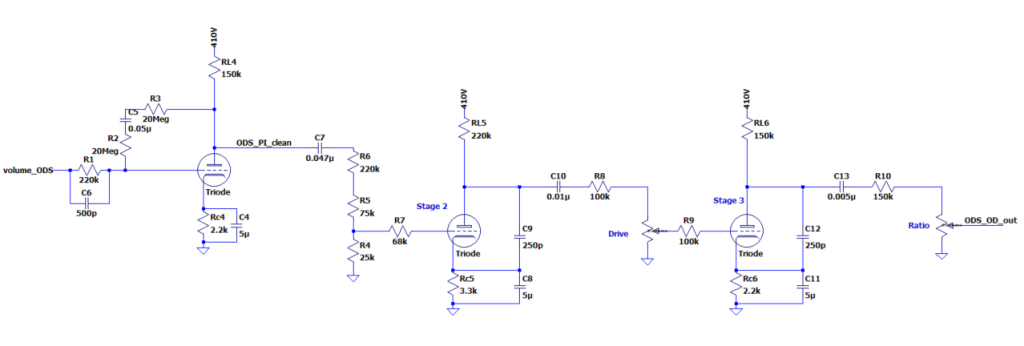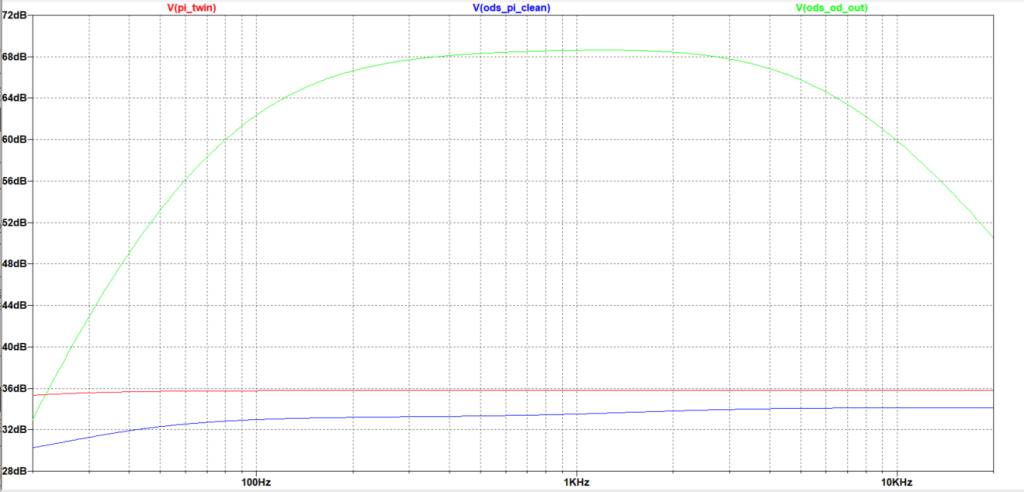Intro
This will be the final circuit analysis article for the ODS #102, and it will cover everything after the tone stack but before the phase inverter. In addition to the tone stack, this is the place where Dumble’s circuit diverged most heavily from the Fender Twin Reverb, adding an overdrive channel and master volume.
Fender Twin Reverb and Dumble ODS Clean Channel
Because the tone stack and master volume are passive, they tend to load the input gain stages. For that reason, it’s extremely common in tube amp designs to put another gain stage or two after the tone stack to aid in gain recovery or simply provide a high input impedance/low output impedance buffer for the tone stack.
In Fender’s AB763 amps with reverb and vibrato* (like the Twin Reverb), the normal channel has 1 gain stage after the tone stack but before the phase inverter. The vibrato channel has a 2nd gain stage that acts as a recovery for the reverb circuit. It doesn’t introduce a ton more gain, and the ODS is based more on the normal channel in this respect, so I’ll ignore it for now.
The schematics are as follows:

The Fender Twin schematic is on the left and ODS on the right. The first thing to note is the Fender cathode resistor, Rc3. I have it listed as 1.6k ohms, but if you look at a schematic, you may note that it’s 820 ohms. Both channels’ post-tone stack gain stages share the cathode resistor, so each stage effectively sees 1640 ohms in parallel. In order to get the correct bias, I used 1.6k.
Also of note, the ODS has a couple of additions. There’s the parallel RC made up of R1 and C6 on the grid and there’s the RCR feeding back from the output to the grid made up of R2, R3, and C5. I’ll skip the detailed circuit analysis and show what they do:

The Twin Reverb gain stage, shown in red, is straightforward, 36dB of gain across the audio spectrum just starting to roll off at 20Hz. The ODS gain stage is lower gain overall with a low-mid shelf and a more pronounced bass rolloff. The ODS has slightly more gain before the tone stack and the tone stack loads it slightly less. There’s also a lot more midrange available in the tone stack of the ODS, so you can see why these adjustments were made.
Not pictured in the schematic, but of note, the ODS also has a master volume after the clean gain stage. That means if you turn the input volume all the way up but the master volume down, you’ll get all the gain in the preamp without making the power amp incredibly loud–like you might on a Fender Twin.
*This is what Fender calls it. It’s actually tremolo. Meanwhile, the “tremolo” they installed on Stratocasters is actually vibrato. Go figure.
Dumble ODS Overdrive Channel
Things getting interesting when you engage the Dumble’s overdrive channel. The overdrive channel is not actually an independent channel–rather it keeps the clean channel and EQ fully in tact, and introduces additional gain stages after the one seen above, like so:

The first stage is the one I looked at above from the clean channel, the drive channel adds what I have labeled as Stage 2 and Stage 3.
Stage 2 is slightly lower gain than the stages before it, and is biased slightly cold (but not JCM800 or SLO cold-clipper level), but it still provides more gain to the circuit.
Stage 3 provides yet another high gain stage, and when everything is turned up, the gain after tone stack to the input of the master volume is profoundly higher than the clean channel or twin reverb:

There’s 68dB of gain compared to 36 dB and 34 dB from the Twin and ODS Clean channel respectively. It’s somewhat mid focused, rolling off at around 100 Hz and 5 kHz–apocryphally trying to mimic how a cranked Super Reverb sounds.
This is enough gain that if we were to look at a transient simulation you’d see a significant amount of clipping on the output signal going into the PI at this point. Again not pictured–the Master Volume moves to the output of Stage 3 with this channel is engaged. The fact that you can then dial back some of the signal without losing the clipping using the master volume before it hits the phase inverter is indeed what makes this an overdrive stage. You can get lots of distortion without all the volume.
But what’s particularly interesting about Stage 3 is the potentiometers at the input (Drive) and output (Ratio). It’s common for high gain amps like this to use a resistor divider to dump some signal between stages so the gain doesn’t turn into a fuzzy mess. The Dumble ODS lets you have access to these controls as external pots. If you don’t want the 3rd stage to contribute much more clipping, you can turn down the Drive. If you want clipping from the third stage, you can turn up drive, and set ratio to control the volume relative to your clean channel, since master volume impacts both “channels.”
Having done this analysis, I can now see that when I’ve built this amp, I’ll likely set up Volume and Master Volume on the clean channel to achieve a clean tone I like, and then I will treat the Drive and Ratio almost as their own pseudo Volume and Master Volume within the OD channel.
I can see why guitarists who are very discerning about their overdrive tone like this amp. The EQ is flexible, and the amp offers a lot of control over the gain characteristics.
Conclusion
This wraps up the circuit deep dives for the ODS 102 compared to the Twin Reverb. I basically only covered the preamp, which leaves the power amp and power supply overlooked.
In both cases, Dumble made changes to the typical Fender design, but they were not significant departures. The Twin has a beefy solid state rectified power supply, a long-tail phase inverter, and a high headroom 4x6L6 power amp. This version of the ODS keeps those same features at a high level, and makes changes to double down on the clean headroom after the preamp–the goal here is to get your gain from the preamp.
So, future build logs will actually be documenting the build, which is currently ongoing.
